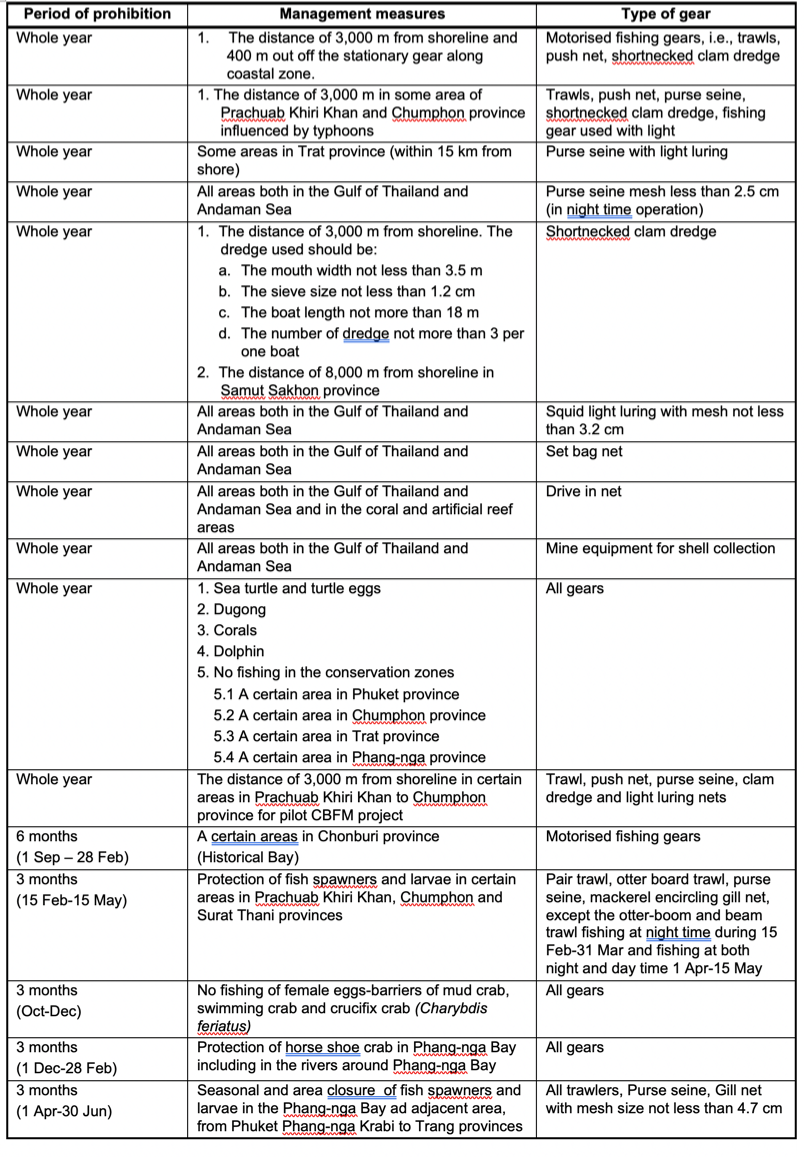Background & Situation Menu
Status and Trends in Fisheries and their Habitats Threats, root causes and barrier analysis Institutional, sectoral and policy context Stakeholder mapping and analysis Baseline analysis and gaps Known Areas of Critical Significance to the Life-Cycles of Fisheries Resources Priority Fisheries Refugia Areas




Establishment of Fisheries Refugia in Thailand:
Background and Situation Analysis to Support
Institutional, sectoral and policy context
This section discusses the basic instruments and support mechanisms for managing marine habitats and populations. It deals with legal instruments, i.e., national laws that also serve as the basis for local ordinances and for the country’s commitment to international agreements, and institutional arrangements in support of fisheries or coastal resources management initiatives, including the roles of various government agencies, research and academic institutions, and the local government units in monitoring, control, and enforcement. This section also examines patterns of resource ownership, the capacity of human resources and institutions to perform research, monitoring, control, and surveillance, as well as the role of management bodies and stakeholders in managing fisheries and coastal resources.
Legal instruments
Thailand is currently implementing several key legal instruments in order to conserve, preserve, protect, and manage fish stocks and their habitats. These legal instruments include the:
Constitution of the Kingdom of Thailand relating to natural resources management;
Fisheries Act 1947 (B.E. 2490) and related regulations and notifications, especially concerning transboundary stocks (Articles 19 and 20 of the Fisheries Act 1947 relate to environmental aspects of fishing grounds, including aquatic animal habitats);
National Environmental Quality Act 1992 (B.E. 2535);
Act Determining Plan and Process of Decentralisation of Power to Local Government Organisation 1999 (B.E. 2542);
Navigation in Thai Waters Act 1913 (B.E. 2456);
The Act Governing the Right to Fish in Thai Fisheries Waters B.E.2484 (1939); and
Wildlife Reservation and Protection Act 1992 (this Act empowers the Department of Fisheries to protect all animals and their products listed as for preservation and protection, which include all endangered species such as marine mammals, turtles, coral, and seashells).
The recent fisheries regulations that have been issued and implemented in Thai waters are summarised in Table 2.
Table 2. Marine fisheries management measures in Thailand

Institutional arrangements (research, monitoring, control, and enforcement)
At present, the lead government organization with direct responsibility for fisheries, marine resources, and habitat management is the Department of Fisheries, as part of the Ministry of Agriculture and Cooperatives. Other governmental organizations, including the Department of Marine and Coastal Resources and the Office of Environment Policy and Planning, as part of the Ministry of Natural Resources and Environment, also play very important roles in conserving Thailand’s marine resources and environments.
The Marine Fisheries Research and Development Bureau conduct research regarding marine fisheries and resource management. The Bureau’s Marine Fisheries Research and Development Centre has locations in 4 regions of the Gulf of Thailand, namely Rayong, Samut Prakan, Chumphon, and Songkhla. Marine and coastal research is also conducted by a newer organization, the Department of Marine and Coastal Resources, through its regional research centers.
A number of other government organizations contributed to various aspects of marine resource and environmental management. They can be considered as supporting research agencies for the Department of Fisheries. They include many organizations under the Department of Pollution Control, Department of National Park Conservation and Management, Department of Marine Transportation and Commerce, Burapha University, Kasetsart University, Chulalongkorn University, Songkhla University, and Walailuk University.
Monitoring, control and surveillance (MCS), is a very important mechanism for fisheries and resource management in the Gulf of Thailand. The Fisheries Administration and Resource Management Bureau of the Department of Fisheries is the leading organization responsible for MCS, and is supported by various Provincial Fisheries Offices and other organizations empowered by the Fisheries Act and Ministerial Notifications of the Ministry of Agriculture and Cooperatives.
When the government agencies reform program took place in October 2002, the Department of Marine and Coastal Resources (DMCR) was established under the Ministry of Natural Resources and Environment. The DMCR was given the mandate to develop relevant regulations in order to achieve effective managerial action relevant to vulnerable resources, including resource preservation and conservation for sustainable use. The MCS activities for the conservation of marine and coastal resources and habitats are under the mandate of the office of Marine and Coastal Conservation and Enforcement. The transfer of some authority for enforcement of the Fisheries Act has taken place in order to empower the DMCR to act in an enforcement capacity.
Additionally, Section 290 of the Constitution of the Kingdom of Thailand states that “For the purpose of promoting and maintaining the quality of the environment, a local government organization has powers and duties as provided by law” for the: management, preservation, and exploitation of the natural resources and environment in the area of the locality; the participation in the preservation of natural resources and environment outside the area of the locality only in the case where the living of the inhabitants in the area may be affected; and the participation in considering the initiation of any project or activity outside the area of the locality which may affect the quality of the environment, health or sanitary conditions of inhabitants in the area.